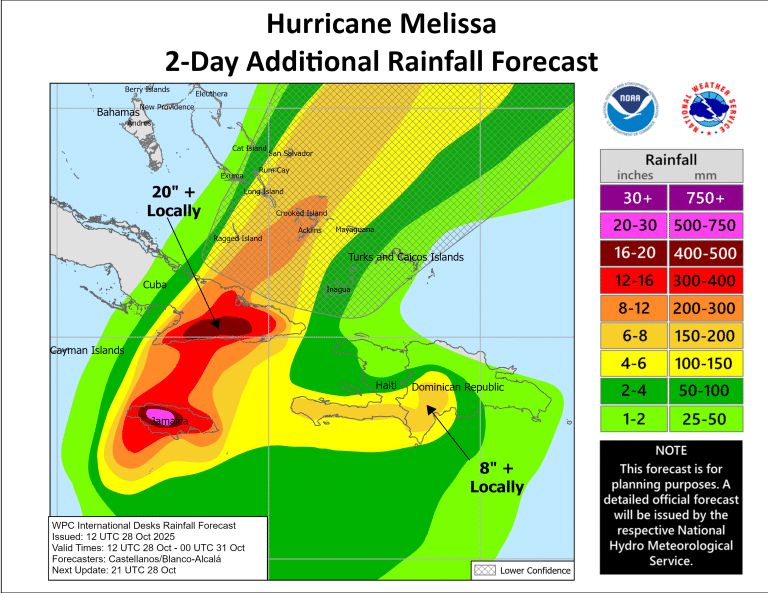Millions of people in Jamaica and across the Caribbean are bracing for massive impact from Hurricane Melissa, the strongest tropical cyclone this year anywhere in the world.
Melissa is a category 5 strength on the Saffir Simpson, nearing landfall in Jamaica - bringing with it life-threatening winds of nearly 300 km/h, devastating storm surge and rainfall.
"This is an extremely dangerous and a life-threatening situation. Take action now to protect your life! Residents in the Jamaica should not leave their shelter as winds will rapidly increase within the eyewall of Melissa. Remain in place through the passage of these life-threatening conditions," said an advisory from the WMO's Regional Specialized Meteorological Center Miami operated US National Hurricane Center.
In rare language, it warned of "total structural failure" near the path of Melissa's centre.
WMO Secretary-General Celeste Saulo said that the immense threat posed by Melissa highlighted the necessity of WMO's work and the Early Warnings for All initiative.
"Melissa will break many records. But we hope that casualties will be kept to a minimum thanks to the power of prediction, the benefits of international and regional cooperation based on data sharing and observations, and national action and community mobilization based on trust," said Celeste Saulo.
Melissa is the strongest hurricane to hit Jamaica since Hurricane Gilbert in 1988. Many lessons have been learned since then - with more accurate forecasts, longer lead times, and better early warnings.
Jamaican authorities closed the island's main airports and issued emergency orders and red alerts with actions to be taken to keep people safe.
Melissa will also impact southeastern Cuba as an extremely dangerous major hurricane, and it will still be at hurricane strength when it moves across the southeastern Bahamas.
Anne-Claire Fontan, a scientist with WMO's Tropical Cyclone programme, explained that the system will bring three times the normal amount of precipitation for a rainy month in Jamaica, or up to 700 millimeters.
"It means that there will be a catastrophic flash flooding and numerous landslides," she explained. "In addition to the rain and to the destructive wind, you will have storm surge that is expected as well on the southern coast of Jamaica with a three to four meters high in addition to destructive waves," she told a media briefing.
The fact that Melissa is slow-moving will worsen the impact of the rainfall.
Evan Thompson, principal director at Jamaica's national meteorological service and the president of WMO's Regional Association for North America, Central America and the Caribbean, joined government leaders in regular televised press conferences to warn the public of the extreme danger through a series of red alerts. Weather Alerts - Meteorological Service of Jamaica
Melissa is the most dangerous storm in an otherwise relatively low-impact hurricane season. But it takes only one landfalling hurricane to wipe out years of development.
It is the strongest storm so far this year - more powerful than Typhoon Ragusa in September 2025 on the Northwest Pacific.

Humanitarian threat
Aid agencies rushed to support vulnerable communities - including in Haiti which is one of the world's poorest countries.
"Roofs will be tested. Flood water will rise. Isolation will become a harsh reality for many," said Necephor Mghendi, the International Federation of the Red Cross and Red Crescent Society's Head of Delegation for the English and Dutch-speaking Caribbean.
"The humanitarian threat is severe and it's immediate," he said.
Many families are currently still rebuilding from the impacts of Beryl last year and restoring their livelihoods in the Caribbean.
"Melissa now threatens the same communities and maybe all the activities will be wiped out," he warned. "This is an example of how… extreme climate weather events can actually provide shocks to communities and stretch the capacities to withstand them," he explained.






